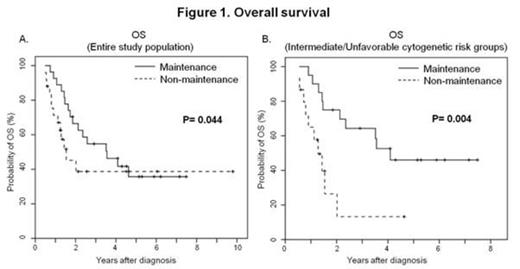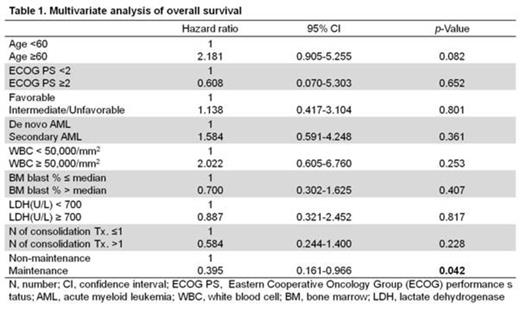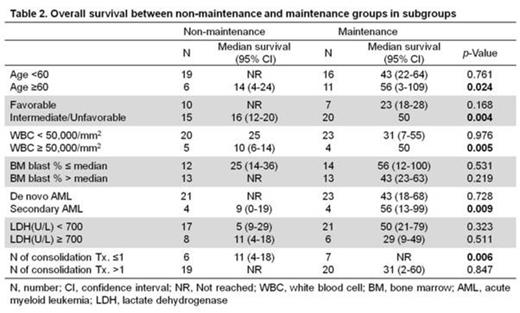Abstract
Background: There is no standard treatment strategy for maintaining first complete remission (CR1) status after several cycles of consolidation chemotherapy in acute myeloid leukemia (AML) patients who are not suitable for transplantation. Maintenance chemotherapy has failed to document the cure rate or prolongation of survivals in patients with acute myeloid leukemia (AML) except for acute promyelocytic leukemia (APL). In this study, we retrospectively compared leukemia free (LFS) and overall survival (OS) of patients with or without maintenance therapy.
Methods: Maintenance chemotherapy consisted of daily 6-mercaptopurine and weekly methotrexate per os and lasted for 2 years. Patients who maintained CR1 status after completion of consolidation therapy started maintenance chemotherapy.
Results: Fifty two patients (not suitable for transplantation) who completed at least 1 cycle of consolidation therapy were eligible for analysis. Twenty seven patients agreed to administrate oral maintenance chemotherapy whereas 25 patients refused. Median age was 52 years and 24 patients were male. According to the FAB classification, 7.7, 9.6, 40.4, 38.5, 1.9 and 1.9% of patients are AML M0, M1, M2, M4, M6 and M7, respectively. Myelodysplastic syndrome (MDS) related and chemotherapy-related secondary AML patients were 5.6 and 9.6%, respectively. Favorable, intermediate and unfavorable cytogenetic risk groups were 32.7, 63.5 and 2%, respectively. Of 33 patients with intermediate risk, 84.8, 12.1 and 3% were normal karyotype, other not-defined and +8 alone, respectively. Two patients with unfavorable risk were complex karyotype and inv(3). There was no significant difference in the patients' characteristics between non-maintenance and maintenance group. Almost of all patients (96.4%) received remission induction therapy with a same protocol (7-3 regimen). Relapse was observed in 27 patients (51.9%) after achieving CR1. Median LFS and OS was 28 (95% CI, 2–54) and 29 months (95% CI, 6–52), respectively. The OS was 19 (95% CI, 8–30) and 43 months (95% CI, 19–67) in non-maintenance and maintenance group, respectively (p = 0.044, Fig 1A), whereas LFS was not significantly different. In multivariate analysis, the presence of maintenance therapy was an independent prognostic factor for better LFS (p = 0.044) and OS (p = 0.042, Table 1.). In subgroup analysis (Table 2.)., statistically significant clinical benefit from maintenance chemotherapy was observed in patients with older age (>= 60 years) (p = 0.024), intermediate or unfavorable cytogenetic results (p = 0.004, Fig 1B.), initial higher WBC count (>= 50,000/mm3) (p = 0.005), secondary AML (p = 0.009), and receiving less than 2 cycles of consolidation therapy (p = 0.006).
Conclusions: Despite limitation as retrospective analysis with small sample size, our data indicate that maintenance chemotherapy with oral 6-MP and MTX can prolong survivals of patients with AML (except APL) who are not suitable for transplantation as a post-remission therapy particularly with older age, intermediate or unfavorable cytogenetics, initial higher WBC count, secondary AML or receiving less than 2 cycles of consolidation therapy.
No relevant conflicts of interest to declare.
Author notes
Asterisk with author names denotes non-ASH members.




This feature is available to Subscribers Only
Sign In or Create an Account Close Modal